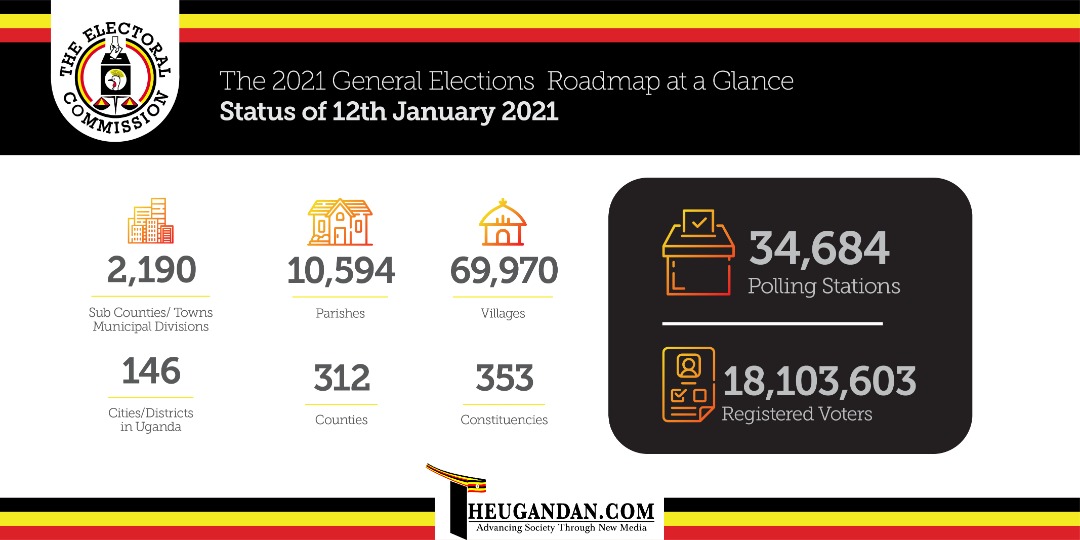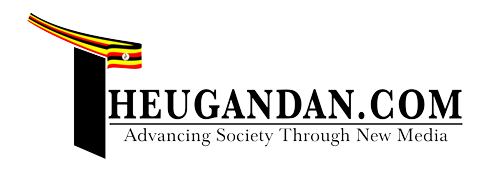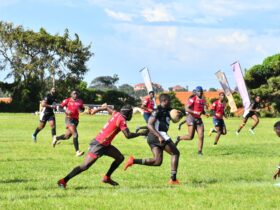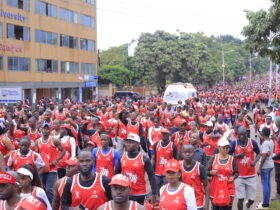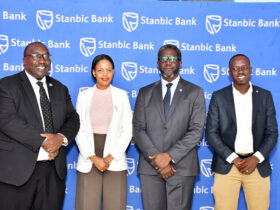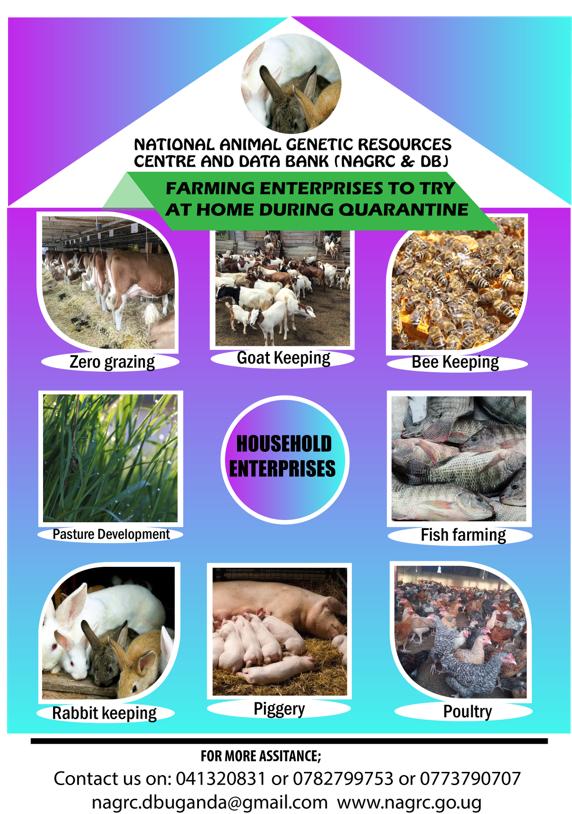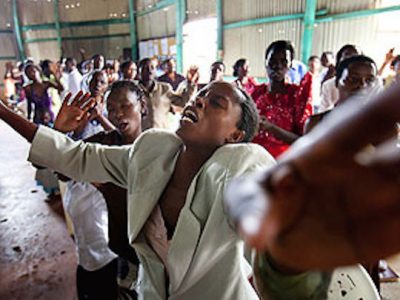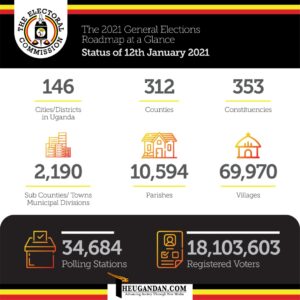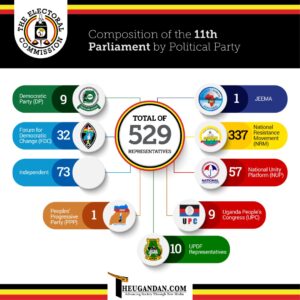Dr. Charles Lagu, PhD (Executive Director, NAGRC&DB)

Background
The Corona virus (COVID 19) has taken the world by storm. Coronavirus disease (COVID-19) is an infectious disease caused by a new virus. The disease causes respiratory illness (like the flu) with symptoms such as a cough, fever, and in more severe cases, difficulty in breathing. You can protect yourself by washing your hands frequently, avoiding touching your face, and avoiding close contact with people who are unwell. Coronavirus disease spreads primarily through contact with an infected person when they cough or sneeze. It also spreads when a person touches a surface or object that has the virus on it, then touches their eyes, nose, or mouth. Globally as of 8th April, 2020 there are 1,464,852 confirmed cases world wide and 85,397 deaths. Uganda has 53 cases presently.
Livelihood concerns and preparedness
The COVID 19 Pandemic has led to several people being kept at home with limited or even no economic activities taking place. This implies that the country will most likely see more families that were beginning to escape from the 68% subsistence group not in money economy or even become worse off. Stores will most likely get depleted sooner or later and this will create yet another more serious pandemic of food shortage and hence mortalities due to undernourishment and poverty. Therefore it is important that a National Post COVID-19 Food Security Strategy Group (NCFSG) be established to avert the ramifications that are likely to arise out of the COVID 19 pandemic.
Key among the consequences of the COVID 19 pandemic are transitory poverty escapes. Transitory poverty escapes refers to households or individuals that momentarily live above the poverty line only to fall back below the poverty line over short period of time due to unexpected events that have negative economic ramifications. Research by USAID (Scott et al., 2016) shows that in Uganda households with more livestock are less likely to experience transitory poverty escapes than those without. In fact, small livestock (chickens, rabbits, sheep and goats) are particularly important source of insurance for the poor households which help them to cope with shocks and stressors.
Therefore, as the Government collectively put efforts to contain the COVID19 through the medical means, it is crucial that we collectively plan and strategize in equal measure to think and put in place a robust program for food security and household incomes during and aftermath of COVID 19.
The basic purpose of the National COVID-19 Food Security Strategy Group will be to propel an exhaustive and integrated response to achieve a sustainable national food security through focusing on the necessities of small holder farmers; engaging them to comprehend their qualification and ensure adequate compensation from the perspective of animal resources interventions.
Together with several players such as government agencies, non-governmental organizations and the private sector, the group will need to work out a way to ensure that animal resources come in handy to address food security and poverty using short, medium and long term, and cross cutting interventions during and aftermath of COVID19.
The World Health Organization (WHO), the Food and Agriculture Organization (FAO) demands that the per capita milk consumption per annum is 200 litres; Beef, 50 kgs and at least an egg per day per person per year. Currently, the Per capita milk consumption of milk is 62 litres; the per capita meat consumption in Uganda is about 6kgs according to Uganda Bureau of statistics abstract, 2017.
The National Animal Genetic Resources Centre and Data Bank (NAGRC&DB)
The National Animal Genetic Resources Centre and Data Bank is one of the agencies under the Ministry of Agriculture Animal Industry and Fisheries (MAAIF) mandated to guide comprehensive Animal breeding programs in Uganda.
The agency has centre farms spread across the country as follows; Livestock Experimental Station (LES), Bull Stud at Entebbe, Wakiso District; Njeru stock farm, Buikwe district; Aswa Ranch, Pader district; Maruzi Ranch, Apac district; Lusenke Stock farm, Kayunga District; Kasolwe stock farm, Kamuli district; Bulago stock farm, Bulambuli district; Nshaara ranch, Sanga Field Experimental Station, Ruhengyere Field Experimental Station in Kiruhura district and Rubona stock farm in Bunyagabu district.
The agency takes care of Cattle, Goats, Pigs and chickens on the various centre farms which needs to be grazed, fed, watered, and treated in cases of sickness. The agency falls in the category of exceptions of agencies that are to remain working during the curfew and post curfew.
Animal resources perspective during and after COVID 19
Animal resources perspective during and after COVID 19 pandemic can be positioned to address food and income insecurity will include short, medium and long term, and cross cutting interventions:
Short term interventions are aimed at increasing farmers’ access to high quality protein of animal origin and quick cash for purchasing power as they strategize on how best the people of diverse nature affected directly and indirectly by the COVID19 will cope with the ramifications of the covid19 pandemic.
The Medium and long-term interventions on the other hand seek to increase farmers’ incomes through improvements in Production and Productivity enhancement, Market Development and Trade Facilitation. The National Post COVID-19 Food Security Strategy Group will also propose ways in which the animal resources sector will be restructured to safeguard the population should such calamities appear again in future.
Short term interventions
- Rabbit rearing in all NAGRC&DB center farms and their distribution to the youths, women, PWDs and all interest groups as a short term and medium term measure for breeding stock and multiplication to meet the protein needs of the population and create incomes through sales. A rabbit’s gestation period is typically between 31-33 days. Rabbits usually have litters of between 4 and 12 babies (kits), depending on the breed.
- Dual purpose chickens rearing and distribution to the youths, women, PWDs and all interest groups including vulnerable groups to meet household dietary protein needs through eggs and meat, and to increase household incomes through sales. Fertile chicken eggs hatch at the end of the incubation period, about 21 day
Medium term interventions
- Hay and Silage production to bolster animal nutrition for Business for the youths and women
- Multi-nutrient blocks and forage production as a business and entrepreneurial venture for the youths and women.
- Swine production to support nutrition and incomes to communities where this is not a taboo. This will be among the youths, women and special interest groups. The gestation (pregnancy) period of the female pig is 114 days. She will be ready to be bred another time around 5-7 days after her pigs are weaned (removed from nursing). Thus if you wean the litter of pigs at 21 days of age she will come into estrus (heat) around 26-28 days after farrowing (giving birth).
- Apiary farming to bolster production of bees and bee products for ecosystems that support bee farming involving the youths, women, PWDS etc.
- Aquaculture and cage farming to support various interests groups to strengthen protein production to diminish eminent malnourishment epidemic.
- Breeding of quick growing small ruminants for the youths, women and interest groups for household incomes.
- Hydroponic production of fodder to support livestock nutrition
Long term interventions
- Dairy cows for production of milk and dairy products
- Beef Cattle for feedlot establishments for household incomes
- Dairy , beef, poultry, pork, bees, fish products processing and value addition
- Streamlining the storage, supply chain and marketing of livestock and livestock products.
Crosscutting interventions in the animal resources Perspective
- Strengthen the supply chain for liquid Nitrogen and Frozen semen distribution country wide.
- Deepen the community breeding programs focusing on cattle, goats, poultry, pigs and Rabbits.
- Boost the technical and management support to livestock farmers in terms of advisory services and technical bulletins.
- Harness efforts and strategies for water conservation and utilization for livestock use.
- Undertake robust efforts for biogas production and utilization to save energy and improve home energy usage.
- Innovate in the utilization of non-conventional feed resources including usage of plants based remains in the gardens.
- Make it integral programs for mindsets change and mindsets transformation for the youths, women and all the livestock value chain actors in the animal resources sector.
Approach and mode of delivery: the following delivery and approaches will be used and these include; Utilize computerized answers to arrive at family units whose physical developments and ability to relate are limited (I) Social media stages; Web-gateway; Smart telephone applications; E-learning stages; On-line tutoring and instructing; E-meetings (Zoom); TV and Radio television show programs; Mobile uproarious speaker broadcasting and systems administration; Home-to-home material conveyances for domesticated animals and animals items in cool offices.
Contribution to Food security
The fruitful execution of animal resources strategy will prompt expanded family unit animal resources assets creation, in this way adding to the general nourishment security and protein sustenance during and after this COVID-19 pandemic, adding to the national exertion to keep on target such Government systems as the National Development Plan III concentrating on agro-industrialization and Vision 2040 in spite of the normal monetary changes in the fallout of COVID-19.
Gender and other social impact assessment
Food insecurity affects women and the girl child more than any other members of society. This is because in recent times, Nourishment frailty influences the women and the girl child more than some other citizenry in light of the fact that as of late, it is these sections of the family unit which have been viewed as liable for putting nourishment on the table. This intervention will in this manner give the best potential advantages to the most powerless individuals from Ugandan culture.
Expected benefits of Animal Resources Interventions
The 8 million households should be prepared to feed the 45 million Ugandans and the region at large and to rise up out of the COVID-19 emergency more nourishment secure and sustenance improved and enjoying adequate nutrition, and equipped with animal resources production technologies and innovations that enhance their resilience to emergency social, environmental and economic disasters.
Proposed Key drivers of the animal Resources Development during and aftermath of COVID19
The National Animal Genetic Resources Centre and Data Bank (NAGRC&DB) have been able to engage the following actors in the animal resources value chain to synergize efforts and work holistically to drive the interventions being suggested in the short term, medium term, long term plus the cross cutting issues being offered to be undertaken during and aftermath of COVID 19 pandemic. These factors include, MAAIF, NAGRC&DB, the private sector, Excel Hort Consult Agribusiness Incubator (EHCAI) and African Agribusiness Incubators Network (AAIN), Uganda National Farmers Federation, Bushenyi Youth Forum Project (BYFP), Uganda National Farmers Federation, Makerere University, Kentim University, Farmer Groups etc. It is urgent that we plan to mitigate food insecurity and income insecurity post COVID 19 through animal resources interventions.
